PUBH6000: Gender Differences, Depression, and Intervention Strategies
VerifiedAdded on 2023/03/20
|10
|2378
|69
Report
AI Summary
This report examines the prevalence of depression among pregnant women, focusing on the influence of gender and social determinants within the Australian context. It highlights the increased risk faced by women, particularly those from socio-economically disadvantaged backgrounds, and explores the impact of factors like lack of support, domestic violence, and limited access to healthcare. The report delves into the current evidence on depression levels, emphasizing the distinct patterns along gender lines and the adverse prenatal outcomes associated with maternal depression. It also analyzes the social and gender determinants, including ethnicity, education, and marital status, and their connections to depression. The report proposes a health promotion intervention aligned with the Social Ecological Model, emphasizing community-level education and increased social participation to address gender differences and improve health outcomes. The intervention is considered both primary and secondary, aiming to reduce depression during pregnancy through behavioral changes and improved social networks.
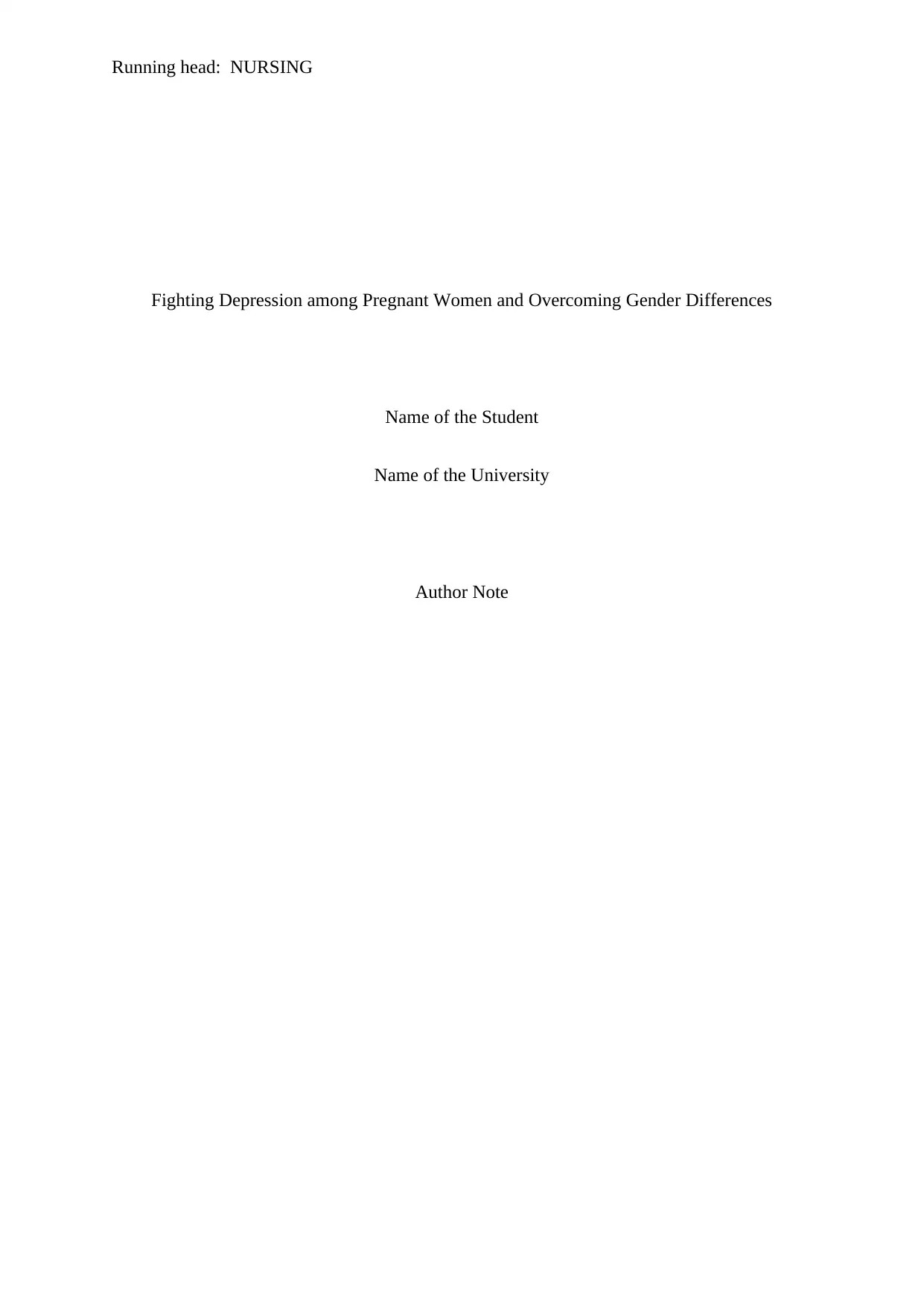
Running head: NURSING
Fighting Depression among Pregnant Women and Overcoming Gender Differences
Name of the Student
Name of the University
Author Note
Fighting Depression among Pregnant Women and Overcoming Gender Differences
Name of the Student
Name of the University
Author Note
Paraphrase This Document
Need a fresh take? Get an instant paraphrase of this document with our AI Paraphraser
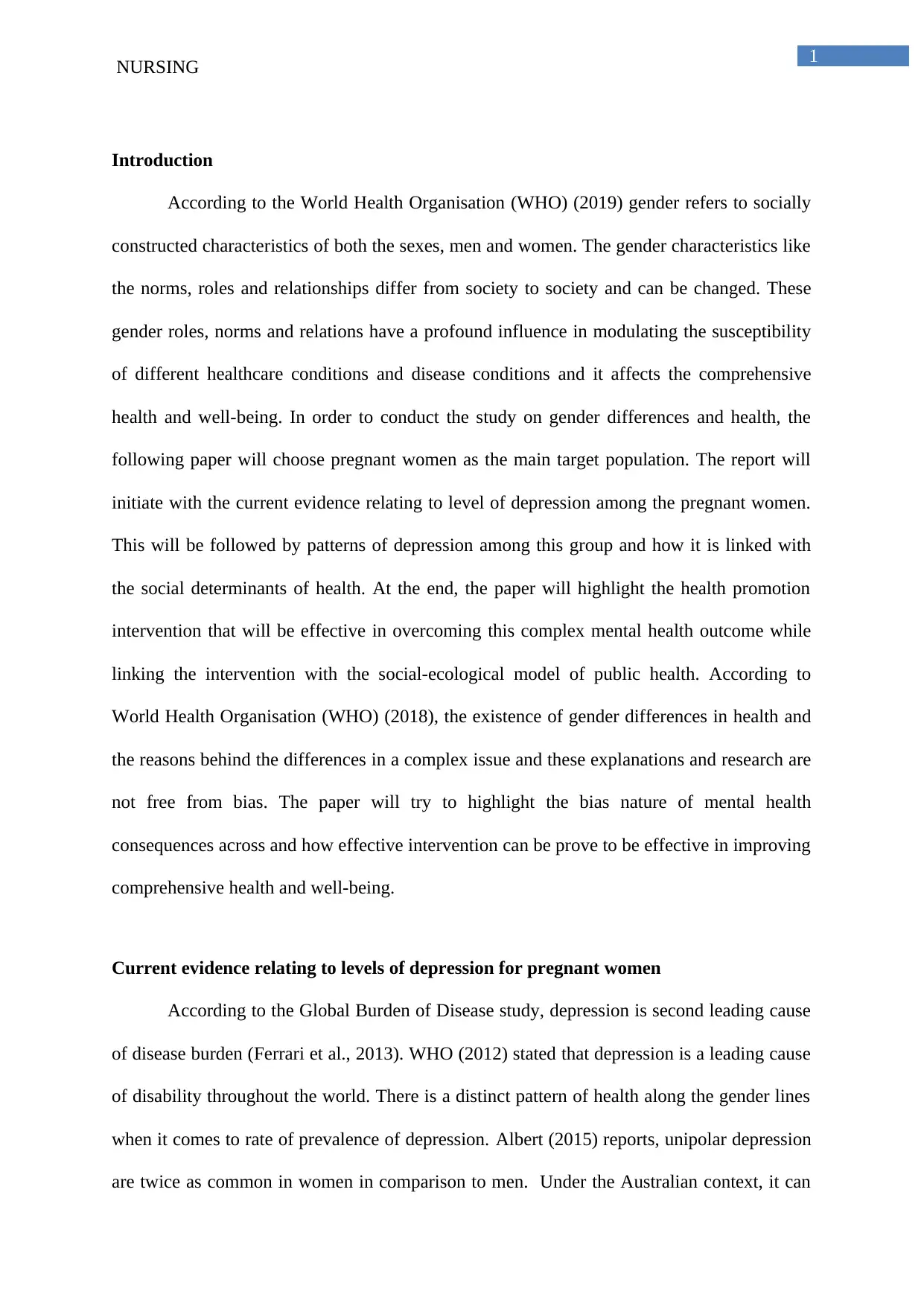
1
NURSING
Introduction
According to the World Health Organisation (WHO) (2019) gender refers to socially
constructed characteristics of both the sexes, men and women. The gender characteristics like
the norms, roles and relationships differ from society to society and can be changed. These
gender roles, norms and relations have a profound influence in modulating the susceptibility
of different healthcare conditions and disease conditions and it affects the comprehensive
health and well-being. In order to conduct the study on gender differences and health, the
following paper will choose pregnant women as the main target population. The report will
initiate with the current evidence relating to level of depression among the pregnant women.
This will be followed by patterns of depression among this group and how it is linked with
the social determinants of health. At the end, the paper will highlight the health promotion
intervention that will be effective in overcoming this complex mental health outcome while
linking the intervention with the social-ecological model of public health. According to
World Health Organisation (WHO) (2018), the existence of gender differences in health and
the reasons behind the differences in a complex issue and these explanations and research are
not free from bias. The paper will try to highlight the bias nature of mental health
consequences across and how effective intervention can be prove to be effective in improving
comprehensive health and well-being.
Current evidence relating to levels of depression for pregnant women
According to the Global Burden of Disease study, depression is second leading cause
of disease burden (Ferrari et al., 2013). WHO (2012) stated that depression is a leading cause
of disability throughout the world. There is a distinct pattern of health along the gender lines
when it comes to rate of prevalence of depression. Albert (2015) reports, unipolar depression
are twice as common in women in comparison to men. Under the Australian context, it can
NURSING
Introduction
According to the World Health Organisation (WHO) (2019) gender refers to socially
constructed characteristics of both the sexes, men and women. The gender characteristics like
the norms, roles and relationships differ from society to society and can be changed. These
gender roles, norms and relations have a profound influence in modulating the susceptibility
of different healthcare conditions and disease conditions and it affects the comprehensive
health and well-being. In order to conduct the study on gender differences and health, the
following paper will choose pregnant women as the main target population. The report will
initiate with the current evidence relating to level of depression among the pregnant women.
This will be followed by patterns of depression among this group and how it is linked with
the social determinants of health. At the end, the paper will highlight the health promotion
intervention that will be effective in overcoming this complex mental health outcome while
linking the intervention with the social-ecological model of public health. According to
World Health Organisation (WHO) (2018), the existence of gender differences in health and
the reasons behind the differences in a complex issue and these explanations and research are
not free from bias. The paper will try to highlight the bias nature of mental health
consequences across and how effective intervention can be prove to be effective in improving
comprehensive health and well-being.
Current evidence relating to levels of depression for pregnant women
According to the Global Burden of Disease study, depression is second leading cause
of disease burden (Ferrari et al., 2013). WHO (2012) stated that depression is a leading cause
of disability throughout the world. There is a distinct pattern of health along the gender lines
when it comes to rate of prevalence of depression. Albert (2015) reports, unipolar depression
are twice as common in women in comparison to men. Under the Australian context, it can
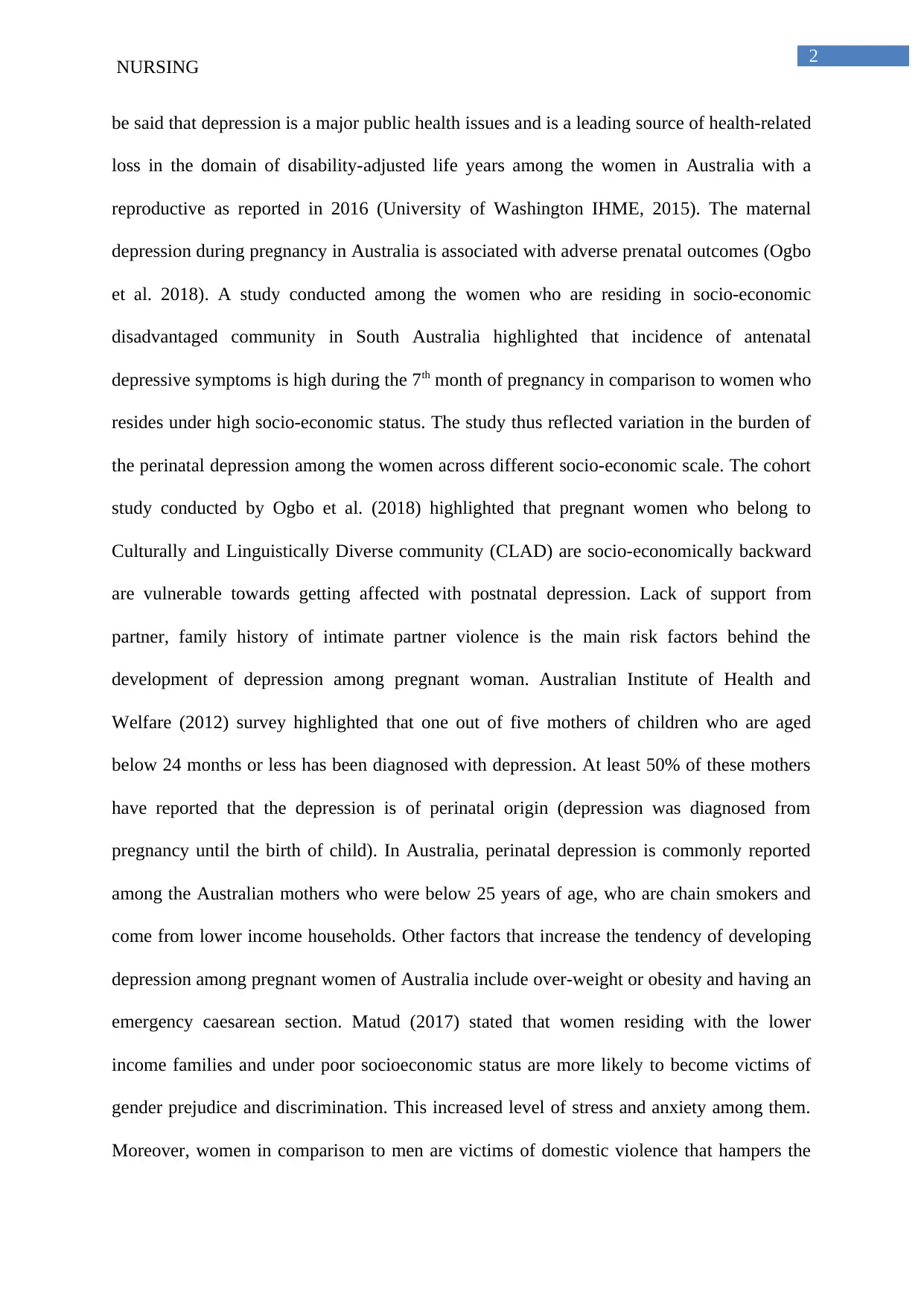
2
NURSING
be said that depression is a major public health issues and is a leading source of health-related
loss in the domain of disability-adjusted life years among the women in Australia with a
reproductive as reported in 2016 (University of Washington IHME, 2015). The maternal
depression during pregnancy in Australia is associated with adverse prenatal outcomes (Ogbo
et al. 2018). A study conducted among the women who are residing in socio-economic
disadvantaged community in South Australia highlighted that incidence of antenatal
depressive symptoms is high during the 7th month of pregnancy in comparison to women who
resides under high socio-economic status. The study thus reflected variation in the burden of
the perinatal depression among the women across different socio-economic scale. The cohort
study conducted by Ogbo et al. (2018) highlighted that pregnant women who belong to
Culturally and Linguistically Diverse community (CLAD) are socio-economically backward
are vulnerable towards getting affected with postnatal depression. Lack of support from
partner, family history of intimate partner violence is the main risk factors behind the
development of depression among pregnant woman. Australian Institute of Health and
Welfare (2012) survey highlighted that one out of five mothers of children who are aged
below 24 months or less has been diagnosed with depression. At least 50% of these mothers
have reported that the depression is of perinatal origin (depression was diagnosed from
pregnancy until the birth of child). In Australia, perinatal depression is commonly reported
among the Australian mothers who were below 25 years of age, who are chain smokers and
come from lower income households. Other factors that increase the tendency of developing
depression among pregnant women of Australia include over-weight or obesity and having an
emergency caesarean section. Matud (2017) stated that women residing with the lower
income families and under poor socioeconomic status are more likely to become victims of
gender prejudice and discrimination. This increased level of stress and anxiety among them.
Moreover, women in comparison to men are victims of domestic violence that hampers the
NURSING
be said that depression is a major public health issues and is a leading source of health-related
loss in the domain of disability-adjusted life years among the women in Australia with a
reproductive as reported in 2016 (University of Washington IHME, 2015). The maternal
depression during pregnancy in Australia is associated with adverse prenatal outcomes (Ogbo
et al. 2018). A study conducted among the women who are residing in socio-economic
disadvantaged community in South Australia highlighted that incidence of antenatal
depressive symptoms is high during the 7th month of pregnancy in comparison to women who
resides under high socio-economic status. The study thus reflected variation in the burden of
the perinatal depression among the women across different socio-economic scale. The cohort
study conducted by Ogbo et al. (2018) highlighted that pregnant women who belong to
Culturally and Linguistically Diverse community (CLAD) are socio-economically backward
are vulnerable towards getting affected with postnatal depression. Lack of support from
partner, family history of intimate partner violence is the main risk factors behind the
development of depression among pregnant woman. Australian Institute of Health and
Welfare (2012) survey highlighted that one out of five mothers of children who are aged
below 24 months or less has been diagnosed with depression. At least 50% of these mothers
have reported that the depression is of perinatal origin (depression was diagnosed from
pregnancy until the birth of child). In Australia, perinatal depression is commonly reported
among the Australian mothers who were below 25 years of age, who are chain smokers and
come from lower income households. Other factors that increase the tendency of developing
depression among pregnant women of Australia include over-weight or obesity and having an
emergency caesarean section. Matud (2017) stated that women residing with the lower
income families and under poor socioeconomic status are more likely to become victims of
gender prejudice and discrimination. This increased level of stress and anxiety among them.
Moreover, women in comparison to men are victims of domestic violence that hampers the
⊘ This is a preview!⊘
Do you want full access?
Subscribe today to unlock all pages.

Trusted by 1+ million students worldwide
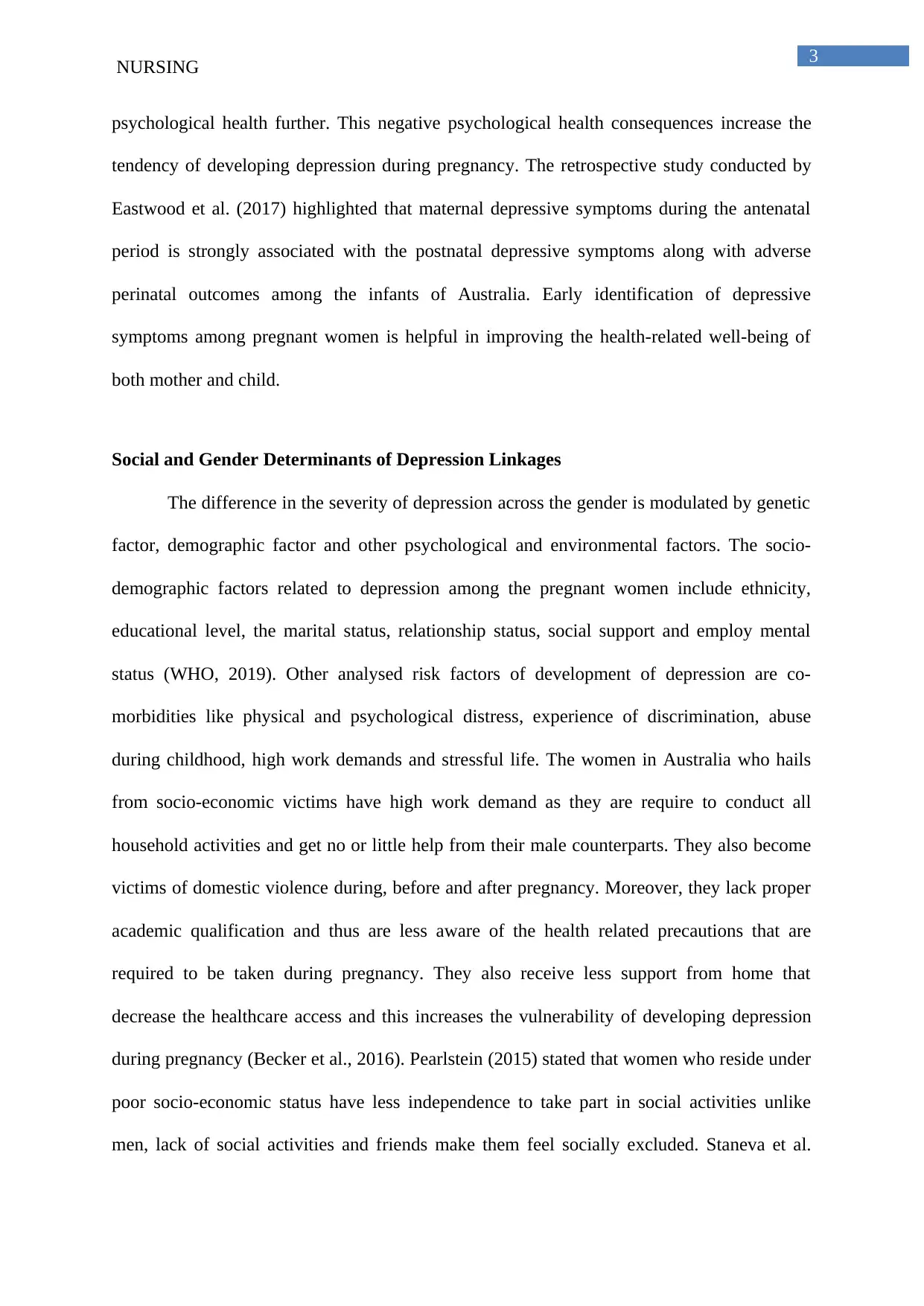
3
NURSING
psychological health further. This negative psychological health consequences increase the
tendency of developing depression during pregnancy. The retrospective study conducted by
Eastwood et al. (2017) highlighted that maternal depressive symptoms during the antenatal
period is strongly associated with the postnatal depressive symptoms along with adverse
perinatal outcomes among the infants of Australia. Early identification of depressive
symptoms among pregnant women is helpful in improving the health-related well-being of
both mother and child.
Social and Gender Determinants of Depression Linkages
The difference in the severity of depression across the gender is modulated by genetic
factor, demographic factor and other psychological and environmental factors. The socio-
demographic factors related to depression among the pregnant women include ethnicity,
educational level, the marital status, relationship status, social support and employ mental
status (WHO, 2019). Other analysed risk factors of development of depression are co-
morbidities like physical and psychological distress, experience of discrimination, abuse
during childhood, high work demands and stressful life. The women in Australia who hails
from socio-economic victims have high work demand as they are require to conduct all
household activities and get no or little help from their male counterparts. They also become
victims of domestic violence during, before and after pregnancy. Moreover, they lack proper
academic qualification and thus are less aware of the health related precautions that are
required to be taken during pregnancy. They also receive less support from home that
decrease the healthcare access and this increases the vulnerability of developing depression
during pregnancy (Becker et al., 2016). Pearlstein (2015) stated that women who reside under
poor socio-economic status have less independence to take part in social activities unlike
men, lack of social activities and friends make them feel socially excluded. Staneva et al.
NURSING
psychological health further. This negative psychological health consequences increase the
tendency of developing depression during pregnancy. The retrospective study conducted by
Eastwood et al. (2017) highlighted that maternal depressive symptoms during the antenatal
period is strongly associated with the postnatal depressive symptoms along with adverse
perinatal outcomes among the infants of Australia. Early identification of depressive
symptoms among pregnant women is helpful in improving the health-related well-being of
both mother and child.
Social and Gender Determinants of Depression Linkages
The difference in the severity of depression across the gender is modulated by genetic
factor, demographic factor and other psychological and environmental factors. The socio-
demographic factors related to depression among the pregnant women include ethnicity,
educational level, the marital status, relationship status, social support and employ mental
status (WHO, 2019). Other analysed risk factors of development of depression are co-
morbidities like physical and psychological distress, experience of discrimination, abuse
during childhood, high work demands and stressful life. The women in Australia who hails
from socio-economic victims have high work demand as they are require to conduct all
household activities and get no or little help from their male counterparts. They also become
victims of domestic violence during, before and after pregnancy. Moreover, they lack proper
academic qualification and thus are less aware of the health related precautions that are
required to be taken during pregnancy. They also receive less support from home that
decrease the healthcare access and this increases the vulnerability of developing depression
during pregnancy (Becker et al., 2016). Pearlstein (2015) stated that women who reside under
poor socio-economic status have less independence to take part in social activities unlike
men, lack of social activities and friends make them feel socially excluded. Staneva et al.
Paraphrase This Document
Need a fresh take? Get an instant paraphrase of this document with our AI Paraphraser
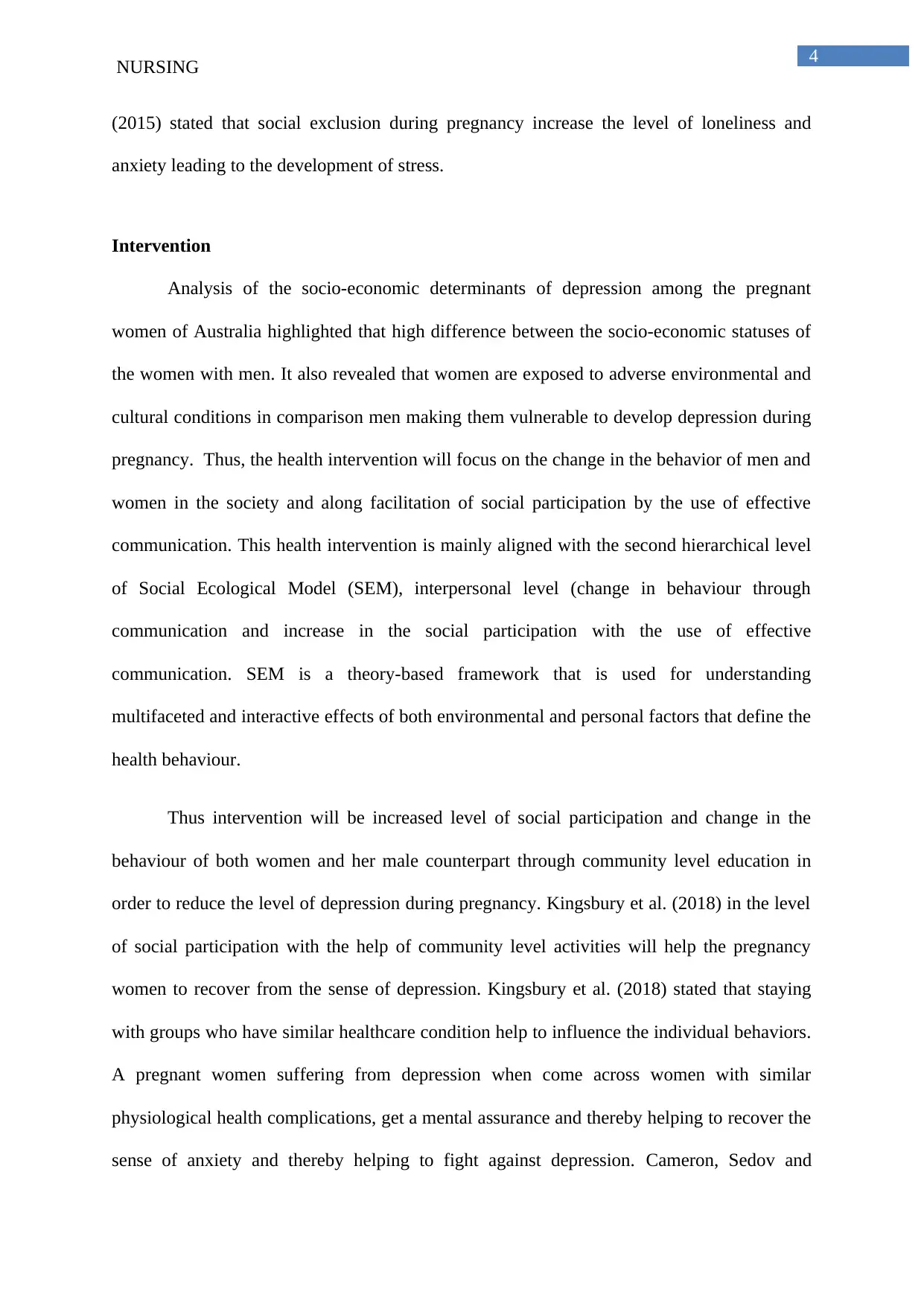
4
NURSING
(2015) stated that social exclusion during pregnancy increase the level of loneliness and
anxiety leading to the development of stress.
Intervention
Analysis of the socio-economic determinants of depression among the pregnant
women of Australia highlighted that high difference between the socio-economic statuses of
the women with men. It also revealed that women are exposed to adverse environmental and
cultural conditions in comparison men making them vulnerable to develop depression during
pregnancy. Thus, the health intervention will focus on the change in the behavior of men and
women in the society and along facilitation of social participation by the use of effective
communication. This health intervention is mainly aligned with the second hierarchical level
of Social Ecological Model (SEM), interpersonal level (change in behaviour through
communication and increase in the social participation with the use of effective
communication. SEM is a theory-based framework that is used for understanding
multifaceted and interactive effects of both environmental and personal factors that define the
health behaviour.
Thus intervention will be increased level of social participation and change in the
behaviour of both women and her male counterpart through community level education in
order to reduce the level of depression during pregnancy. Kingsbury et al. (2018) in the level
of social participation with the help of community level activities will help the pregnancy
women to recover from the sense of depression. Kingsbury et al. (2018) stated that staying
with groups who have similar healthcare condition help to influence the individual behaviors.
A pregnant women suffering from depression when come across women with similar
physiological health complications, get a mental assurance and thereby helping to recover the
sense of anxiety and thereby helping to fight against depression. Cameron, Sedov and
NURSING
(2015) stated that social exclusion during pregnancy increase the level of loneliness and
anxiety leading to the development of stress.
Intervention
Analysis of the socio-economic determinants of depression among the pregnant
women of Australia highlighted that high difference between the socio-economic statuses of
the women with men. It also revealed that women are exposed to adverse environmental and
cultural conditions in comparison men making them vulnerable to develop depression during
pregnancy. Thus, the health intervention will focus on the change in the behavior of men and
women in the society and along facilitation of social participation by the use of effective
communication. This health intervention is mainly aligned with the second hierarchical level
of Social Ecological Model (SEM), interpersonal level (change in behaviour through
communication and increase in the social participation with the use of effective
communication. SEM is a theory-based framework that is used for understanding
multifaceted and interactive effects of both environmental and personal factors that define the
health behaviour.
Thus intervention will be increased level of social participation and change in the
behaviour of both women and her male counterpart through community level education in
order to reduce the level of depression during pregnancy. Kingsbury et al. (2018) in the level
of social participation with the help of community level activities will help the pregnancy
women to recover from the sense of depression. Kingsbury et al. (2018) stated that staying
with groups who have similar healthcare condition help to influence the individual behaviors.
A pregnant women suffering from depression when come across women with similar
physiological health complications, get a mental assurance and thereby helping to recover the
sense of anxiety and thereby helping to fight against depression. Cameron, Sedov and
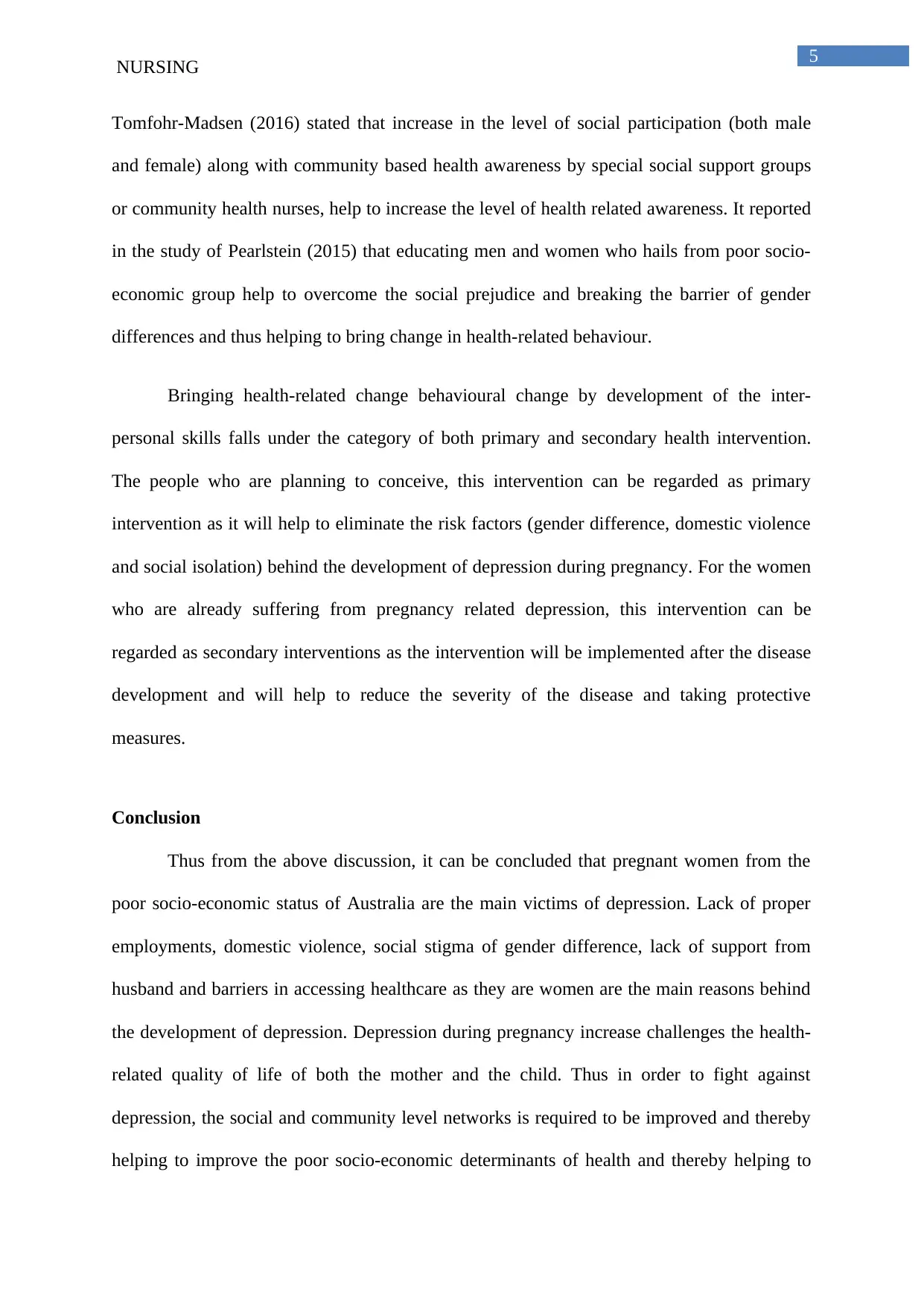
5
NURSING
Tomfohr-Madsen (2016) stated that increase in the level of social participation (both male
and female) along with community based health awareness by special social support groups
or community health nurses, help to increase the level of health related awareness. It reported
in the study of Pearlstein (2015) that educating men and women who hails from poor socio-
economic group help to overcome the social prejudice and breaking the barrier of gender
differences and thus helping to bring change in health-related behaviour.
Bringing health-related change behavioural change by development of the inter-
personal skills falls under the category of both primary and secondary health intervention.
The people who are planning to conceive, this intervention can be regarded as primary
intervention as it will help to eliminate the risk factors (gender difference, domestic violence
and social isolation) behind the development of depression during pregnancy. For the women
who are already suffering from pregnancy related depression, this intervention can be
regarded as secondary interventions as the intervention will be implemented after the disease
development and will help to reduce the severity of the disease and taking protective
measures.
Conclusion
Thus from the above discussion, it can be concluded that pregnant women from the
poor socio-economic status of Australia are the main victims of depression. Lack of proper
employments, domestic violence, social stigma of gender difference, lack of support from
husband and barriers in accessing healthcare as they are women are the main reasons behind
the development of depression. Depression during pregnancy increase challenges the health-
related quality of life of both the mother and the child. Thus in order to fight against
depression, the social and community level networks is required to be improved and thereby
helping to improve the poor socio-economic determinants of health and thereby helping to
NURSING
Tomfohr-Madsen (2016) stated that increase in the level of social participation (both male
and female) along with community based health awareness by special social support groups
or community health nurses, help to increase the level of health related awareness. It reported
in the study of Pearlstein (2015) that educating men and women who hails from poor socio-
economic group help to overcome the social prejudice and breaking the barrier of gender
differences and thus helping to bring change in health-related behaviour.
Bringing health-related change behavioural change by development of the inter-
personal skills falls under the category of both primary and secondary health intervention.
The people who are planning to conceive, this intervention can be regarded as primary
intervention as it will help to eliminate the risk factors (gender difference, domestic violence
and social isolation) behind the development of depression during pregnancy. For the women
who are already suffering from pregnancy related depression, this intervention can be
regarded as secondary interventions as the intervention will be implemented after the disease
development and will help to reduce the severity of the disease and taking protective
measures.
Conclusion
Thus from the above discussion, it can be concluded that pregnant women from the
poor socio-economic status of Australia are the main victims of depression. Lack of proper
employments, domestic violence, social stigma of gender difference, lack of support from
husband and barriers in accessing healthcare as they are women are the main reasons behind
the development of depression. Depression during pregnancy increase challenges the health-
related quality of life of both the mother and the child. Thus in order to fight against
depression, the social and community level networks is required to be improved and thereby
helping to improve the poor socio-economic determinants of health and thereby helping to
⊘ This is a preview!⊘
Do you want full access?
Subscribe today to unlock all pages.

Trusted by 1+ million students worldwide
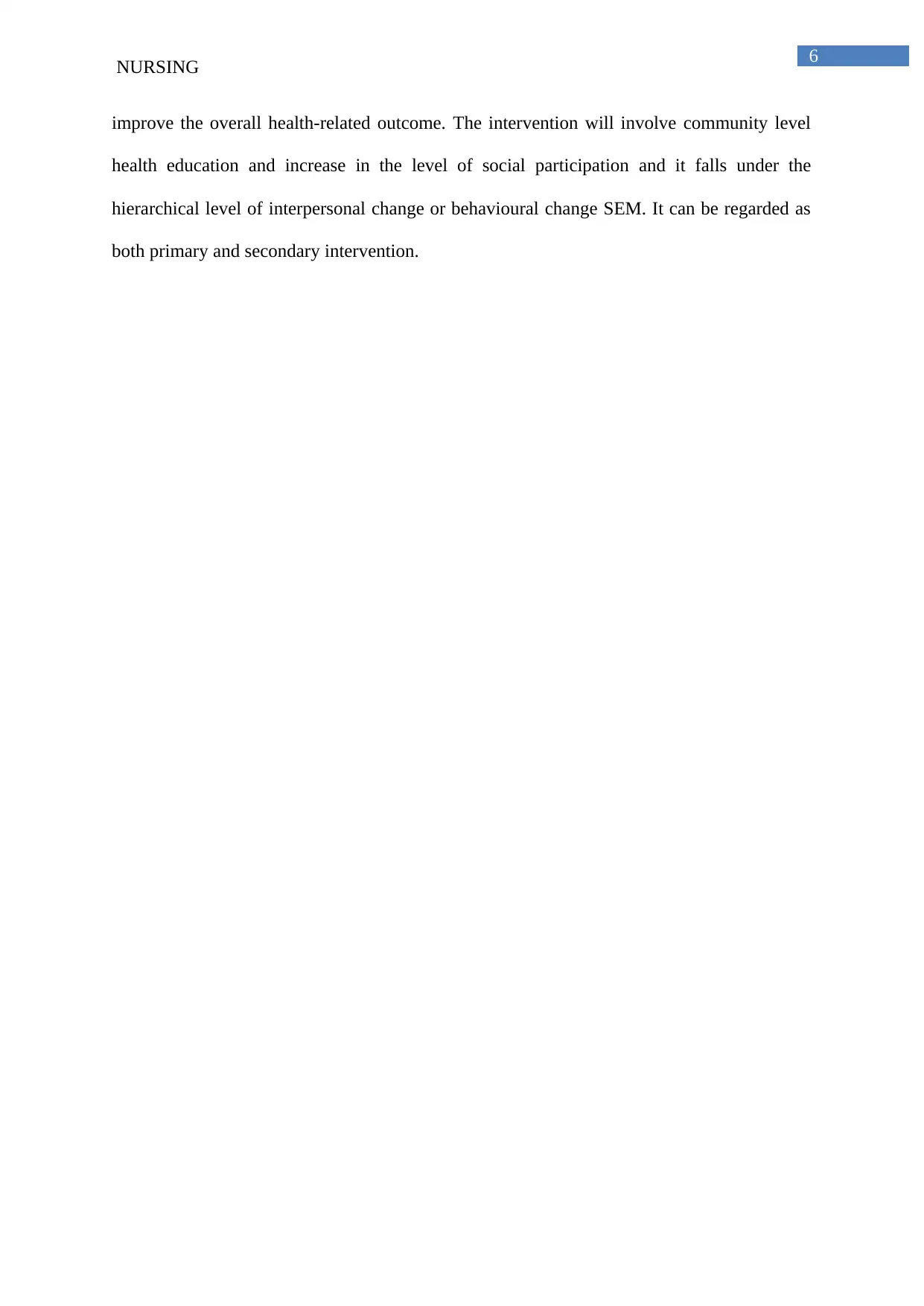
6
NURSING
improve the overall health-related outcome. The intervention will involve community level
health education and increase in the level of social participation and it falls under the
hierarchical level of interpersonal change or behavioural change SEM. It can be regarded as
both primary and secondary intervention.
NURSING
improve the overall health-related outcome. The intervention will involve community level
health education and increase in the level of social participation and it falls under the
hierarchical level of interpersonal change or behavioural change SEM. It can be regarded as
both primary and secondary intervention.
Paraphrase This Document
Need a fresh take? Get an instant paraphrase of this document with our AI Paraphraser
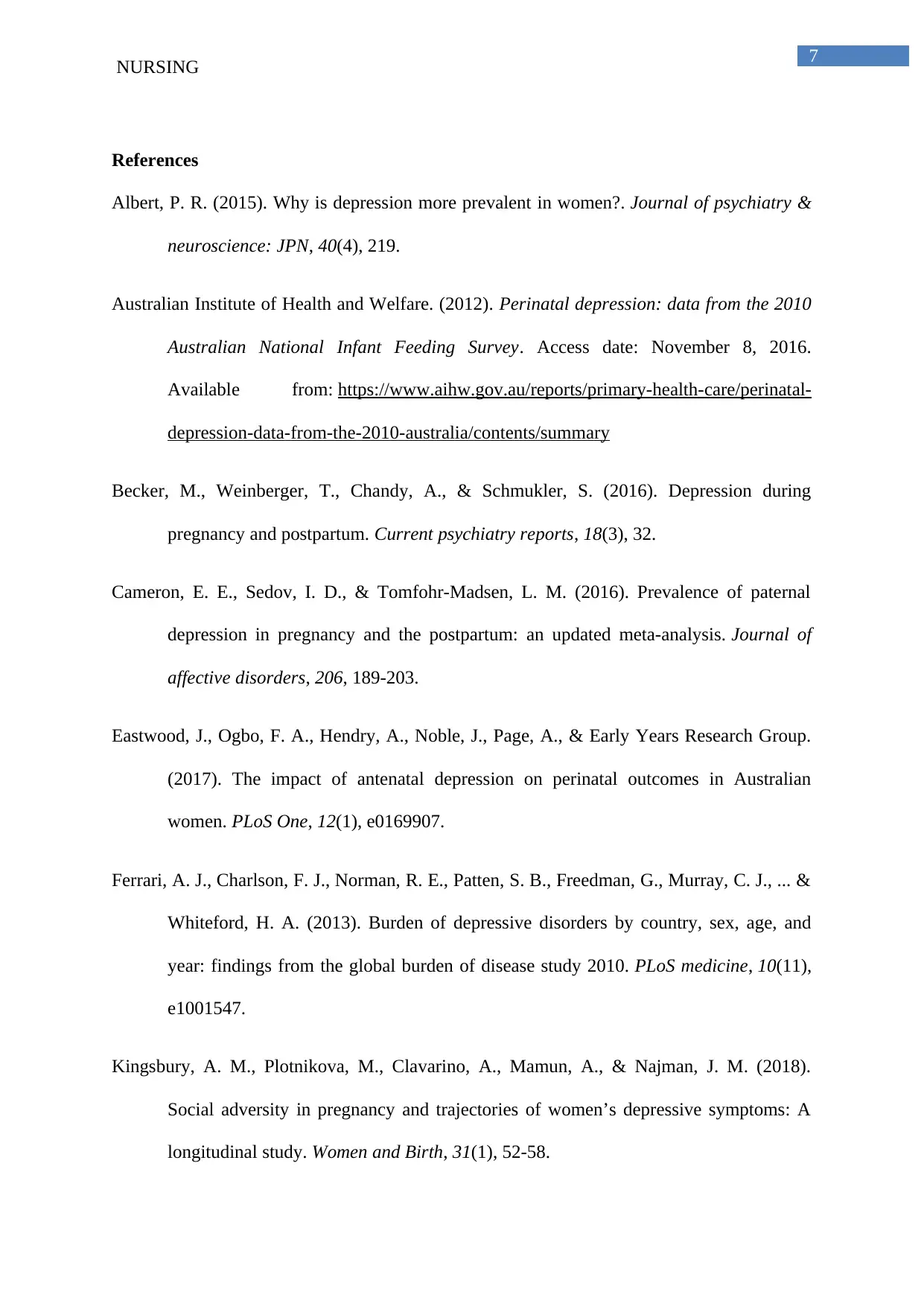
7
NURSING
References
Albert, P. R. (2015). Why is depression more prevalent in women?. Journal of psychiatry &
neuroscience: JPN, 40(4), 219.
Australian Institute of Health and Welfare. (2012). Perinatal depression: data from the 2010
Australian National Infant Feeding Survey. Access date: November 8, 2016.
Available from: https://www.aihw.gov.au/reports/primary-health-care/perinatal-
depression-data-from-the-2010-australia/contents/summary
Becker, M., Weinberger, T., Chandy, A., & Schmukler, S. (2016). Depression during
pregnancy and postpartum. Current psychiatry reports, 18(3), 32.
Cameron, E. E., Sedov, I. D., & Tomfohr-Madsen, L. M. (2016). Prevalence of paternal
depression in pregnancy and the postpartum: an updated meta-analysis. Journal of
affective disorders, 206, 189-203.
Eastwood, J., Ogbo, F. A., Hendry, A., Noble, J., Page, A., & Early Years Research Group.
(2017). The impact of antenatal depression on perinatal outcomes in Australian
women. PLoS One, 12(1), e0169907.
Ferrari, A. J., Charlson, F. J., Norman, R. E., Patten, S. B., Freedman, G., Murray, C. J., ... &
Whiteford, H. A. (2013). Burden of depressive disorders by country, sex, age, and
year: findings from the global burden of disease study 2010. PLoS medicine, 10(11),
e1001547.
Kingsbury, A. M., Plotnikova, M., Clavarino, A., Mamun, A., & Najman, J. M. (2018).
Social adversity in pregnancy and trajectories of women’s depressive symptoms: A
longitudinal study. Women and Birth, 31(1), 52-58.
NURSING
References
Albert, P. R. (2015). Why is depression more prevalent in women?. Journal of psychiatry &
neuroscience: JPN, 40(4), 219.
Australian Institute of Health and Welfare. (2012). Perinatal depression: data from the 2010
Australian National Infant Feeding Survey. Access date: November 8, 2016.
Available from: https://www.aihw.gov.au/reports/primary-health-care/perinatal-
depression-data-from-the-2010-australia/contents/summary
Becker, M., Weinberger, T., Chandy, A., & Schmukler, S. (2016). Depression during
pregnancy and postpartum. Current psychiatry reports, 18(3), 32.
Cameron, E. E., Sedov, I. D., & Tomfohr-Madsen, L. M. (2016). Prevalence of paternal
depression in pregnancy and the postpartum: an updated meta-analysis. Journal of
affective disorders, 206, 189-203.
Eastwood, J., Ogbo, F. A., Hendry, A., Noble, J., Page, A., & Early Years Research Group.
(2017). The impact of antenatal depression on perinatal outcomes in Australian
women. PLoS One, 12(1), e0169907.
Ferrari, A. J., Charlson, F. J., Norman, R. E., Patten, S. B., Freedman, G., Murray, C. J., ... &
Whiteford, H. A. (2013). Burden of depressive disorders by country, sex, age, and
year: findings from the global burden of disease study 2010. PLoS medicine, 10(11),
e1001547.
Kingsbury, A. M., Plotnikova, M., Clavarino, A., Mamun, A., & Najman, J. M. (2018).
Social adversity in pregnancy and trajectories of women’s depressive symptoms: A
longitudinal study. Women and Birth, 31(1), 52-58.
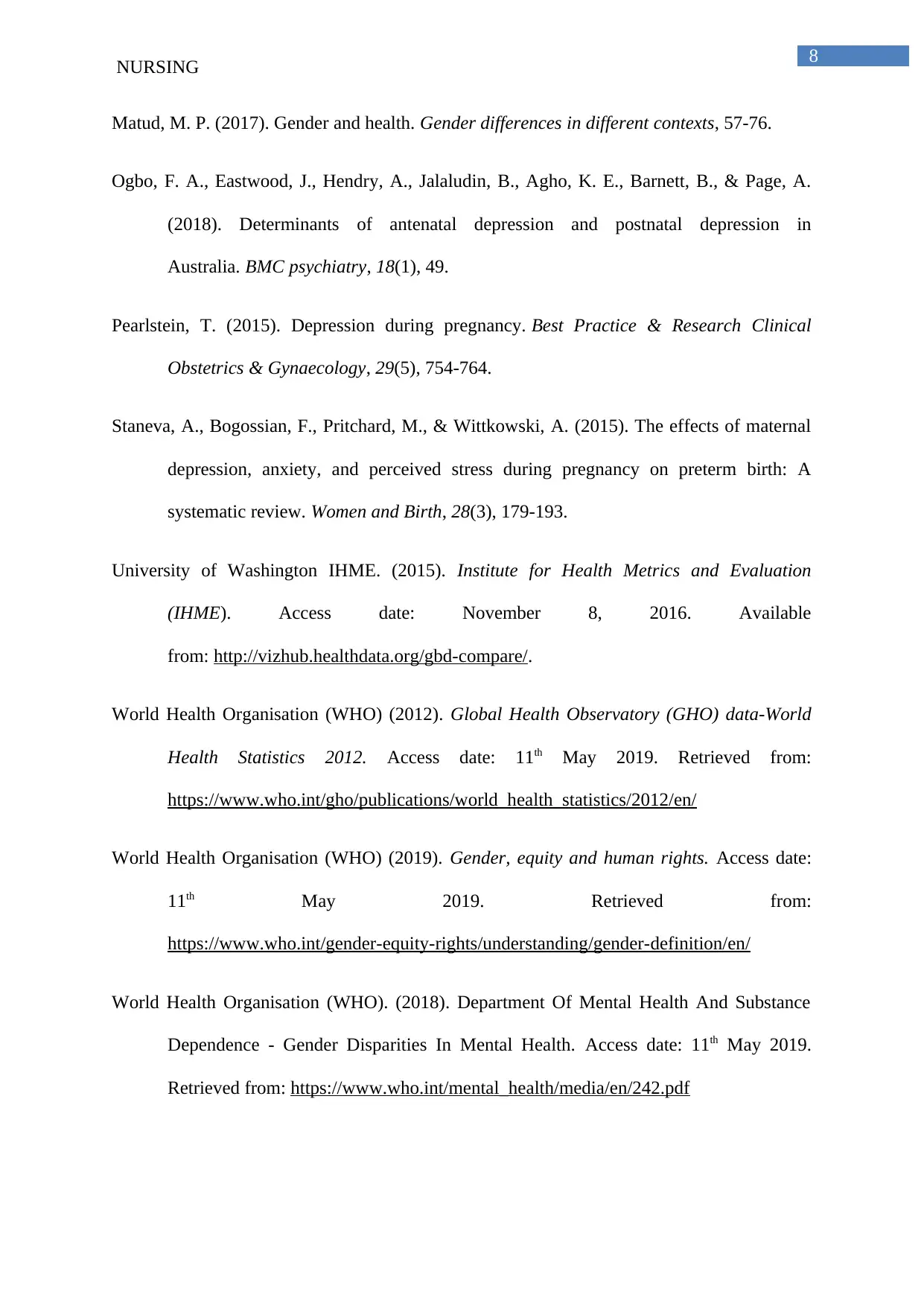
8
NURSING
Matud, M. P. (2017). Gender and health. Gender differences in different contexts, 57-76.
Ogbo, F. A., Eastwood, J., Hendry, A., Jalaludin, B., Agho, K. E., Barnett, B., & Page, A.
(2018). Determinants of antenatal depression and postnatal depression in
Australia. BMC psychiatry, 18(1), 49.
Pearlstein, T. (2015). Depression during pregnancy. Best Practice & Research Clinical
Obstetrics & Gynaecology, 29(5), 754-764.
Staneva, A., Bogossian, F., Pritchard, M., & Wittkowski, A. (2015). The effects of maternal
depression, anxiety, and perceived stress during pregnancy on preterm birth: A
systematic review. Women and Birth, 28(3), 179-193.
University of Washington IHME. (2015). Institute for Health Metrics and Evaluation
(IHME). Access date: November 8, 2016. Available
from: http://vizhub.healthdata.org/gbd-compare/.
World Health Organisation (WHO) (2012). Global Health Observatory (GHO) data-World
Health Statistics 2012. Access date: 11th May 2019. Retrieved from:
https://www.who.int/gho/publications/world_health_statistics/2012/en/
World Health Organisation (WHO) (2019). Gender, equity and human rights. Access date:
11th May 2019. Retrieved from:
https://www.who.int/gender-equity-rights/understanding/gender-definition/en/
World Health Organisation (WHO). (2018). Department Of Mental Health And Substance
Dependence - Gender Disparities In Mental Health. Access date: 11th May 2019.
Retrieved from: https://www.who.int/mental_health/media/en/242.pdf
NURSING
Matud, M. P. (2017). Gender and health. Gender differences in different contexts, 57-76.
Ogbo, F. A., Eastwood, J., Hendry, A., Jalaludin, B., Agho, K. E., Barnett, B., & Page, A.
(2018). Determinants of antenatal depression and postnatal depression in
Australia. BMC psychiatry, 18(1), 49.
Pearlstein, T. (2015). Depression during pregnancy. Best Practice & Research Clinical
Obstetrics & Gynaecology, 29(5), 754-764.
Staneva, A., Bogossian, F., Pritchard, M., & Wittkowski, A. (2015). The effects of maternal
depression, anxiety, and perceived stress during pregnancy on preterm birth: A
systematic review. Women and Birth, 28(3), 179-193.
University of Washington IHME. (2015). Institute for Health Metrics and Evaluation
(IHME). Access date: November 8, 2016. Available
from: http://vizhub.healthdata.org/gbd-compare/.
World Health Organisation (WHO) (2012). Global Health Observatory (GHO) data-World
Health Statistics 2012. Access date: 11th May 2019. Retrieved from:
https://www.who.int/gho/publications/world_health_statistics/2012/en/
World Health Organisation (WHO) (2019). Gender, equity and human rights. Access date:
11th May 2019. Retrieved from:
https://www.who.int/gender-equity-rights/understanding/gender-definition/en/
World Health Organisation (WHO). (2018). Department Of Mental Health And Substance
Dependence - Gender Disparities In Mental Health. Access date: 11th May 2019.
Retrieved from: https://www.who.int/mental_health/media/en/242.pdf
⊘ This is a preview!⊘
Do you want full access?
Subscribe today to unlock all pages.

Trusted by 1+ million students worldwide

9
NURSING
NURSING
1 out of 10
Related Documents
Your All-in-One AI-Powered Toolkit for Academic Success.
+13062052269
info@desklib.com
Available 24*7 on WhatsApp / Email
![[object Object]](/_next/static/media/star-bottom.7253800d.svg)
Unlock your academic potential
Copyright © 2020–2025 A2Z Services. All Rights Reserved. Developed and managed by ZUCOL.





